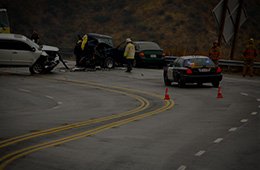Car Accident Essentials
 When you are involved in a car accident, it can be difficult to know what to do next. Since 1985, the attorneys at Drake, Hileman & Davis, have been helping people successfully navigate through the post-accident process. Over the years, we have found that there are certain key steps which anyone can take to ensure personal safety, investigative thoroughness and ultimately justice.
When you are involved in a car accident, it can be difficult to know what to do next. Since 1985, the attorneys at Drake, Hileman & Davis, have been helping people successfully navigate through the post-accident process. Over the years, we have found that there are certain key steps which anyone can take to ensure personal safety, investigative thoroughness and ultimately justice.
SAFETY FIRST
Initially, it should be noted that the nature of your injury, as well as when and where the accident occurred may limit what you are able to do immediately following a collision. The circumstances of your accident will dictate a particular safety response or impose investigative limitations. Remember your safety and the safety of your passengers must be your primary concern. If the collision occurred on a multi-lane highway, especially at night, you should pull to the side of the road (right-side preferably). Remain in your vehicle, with your seat-belt on and your hazard lights flashing, until help arrives. Trying to exit your vehicle on a multi-lane highway is dangerous and can risk further injury. If, however, you smell or see smoke, then turn the engine off and find a safe way to exit your vehicle. Move as far away from your vehicle and oncoming traffic as safely possible, while you wait for help to arrive. It should be noted that many people believe that their vehicle is on fire, due to the white powder that is released, when air bags deploy. While this is startling, it does not require you to exit your vehicle. Always remember to remain calm, as you assess your situation and your ability to make the best decision for your safety.
CONTACT THE POLICE AND CAPTURE EVIDENCE
Once you and your passengers are in a safe location, you should call 911. While waiting for help to arrive, if you are physically able, take pictures of the accident scene, noting skid marks, debris on the roadway, damage to the vehicles, license plate numbers, as well as vehicle location on the roadway. In taking photographs, it is important to include context, as points of reference in the frame of your picture. This would include road signs, traffic control devices, mile markers, poles or trees. These reference points will be beneficial later, when the events that caused or contributed to the crash are trying to be ascertained. Many smart phones record not only the time of the photograph, but the precise location where the photograph was taken.
As you continue to wait for the police to arrive, write down the names and phone numbers of any witnesses who approach you. Sometimes witnesses do not stay on-scene to provide the responding police officers with identification information. So, this may be the only opportunity you have to secure this information.
If you are approached by others involved in the collision, keep your conversation limited to determining if everyone is alright. Allow the police to take down the necessary insurance information and determine who caused the collision. You do not want to get into a debate with other drivers, as to who caused what, or as to the competency of other drivers. Remain calm and avoid heated discussions before the police arrive.
When the police arrive, be sure to tell the investigating officers as much information as you can recall about what caused the collision. If while waiting, you detected an odor of alcohol on the other driver or observed him or her behaving erratically, be sure to mention this to the police. Additionally, on occasion, drivers try to switch seats with passengers in order to avoid certain consequences for their behavior. Be sure to let the police know, if you observed such duplicity.
MEDICAL CARE
If you are in need of medical attention, do not let worries about your own health insurance deductibles or ER co-pays be a reason not to go to the emergency room. In Pennsylvania, your own automobile insurance will provide a minimum of $5,000.00 in medical payment coverage without the payment of a co-pay or a deductible. In New Jersey, there are auto deductibles and co-pays, but they are relatively small, when compared to the benefit of obtaining medical care for your injures. If you are in pain at the accident scene, be sure to get the medical help you need. Not only will you receive necessary medical treatment, but in doing so, your injuries will be documented for future reference should further complications develop to those parts of your body injured in the collision.
Once you have arrived home from the hospital, call your insurance company and report the collision. You will be provided with a claim number for future use. This number will be used for the payment of your medical bills associated with the accident. If you are still in pain the next day, make an appointment to see your family doctor or any specialist that was recommended to you, while in the emergency room.
If your injuries require on-going medical care, whether through in-patient hospitalization; surgery of any kind; or follow-up physical therapy, chiropractic therapy or other therapeutic treatments, you should contact the law firm of Drake, Hileman & Davis in order to discuss your legal rights. You will speak directly with an attorney, who will review both the liability and damage aspects of your claim. All claims are handled on contingency fee basis. No fee unless we recover for you. Contact Drake, Hileman & Davis today at 888-777-7098 for a free case evaluation.

